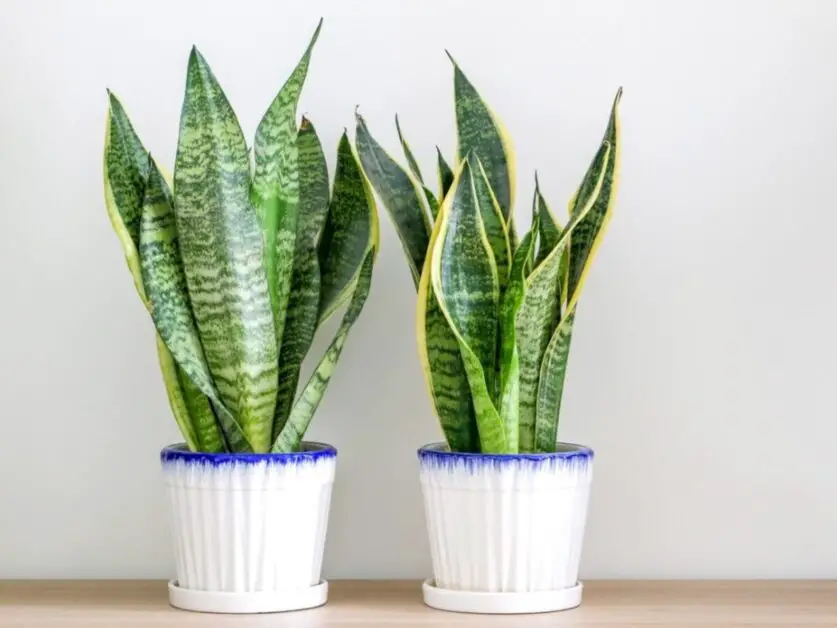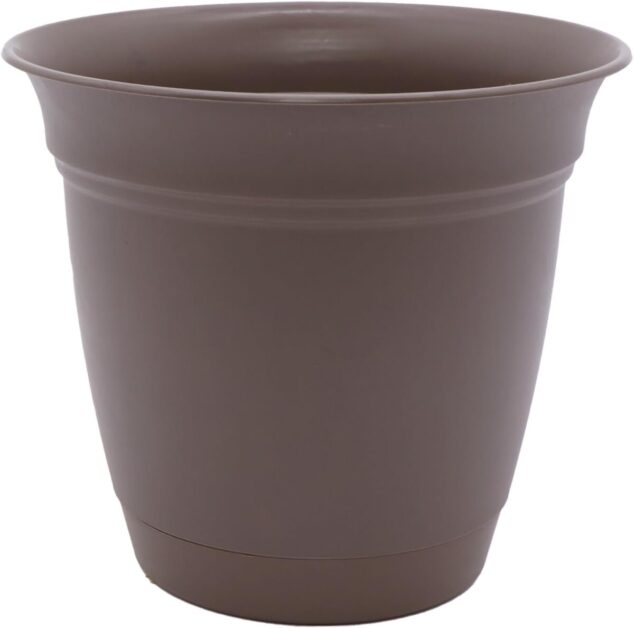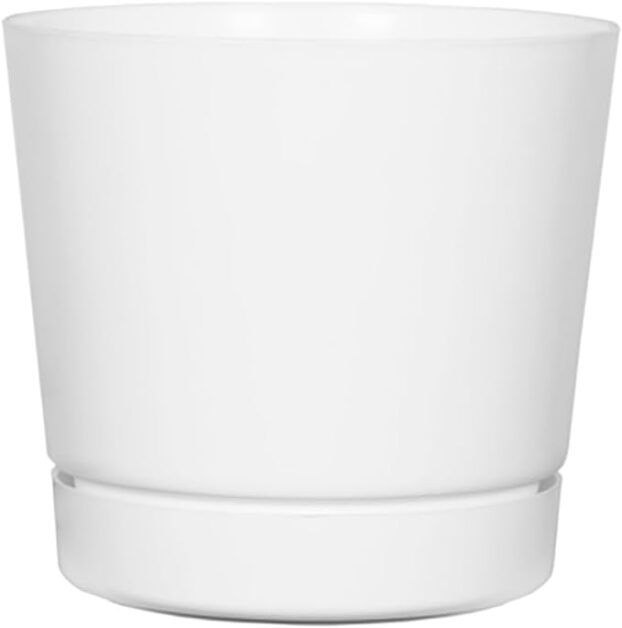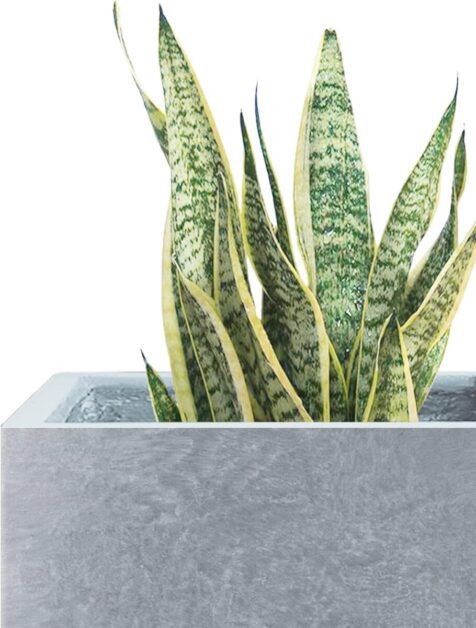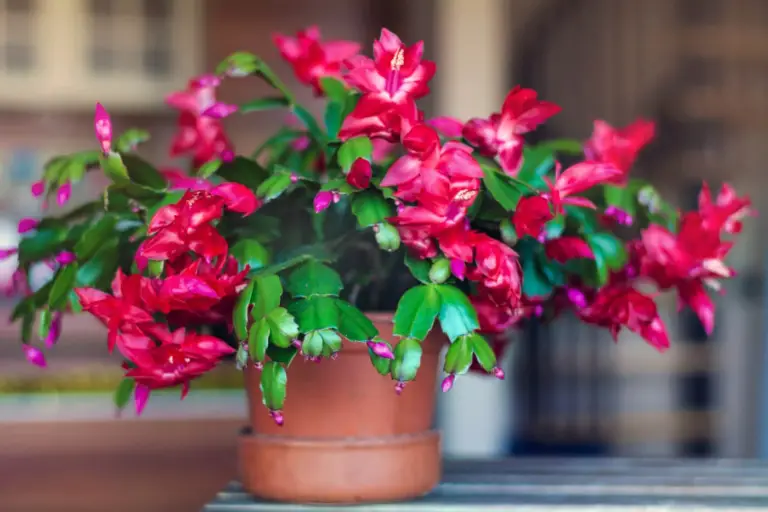Mastering the Art of Repotting Snake Plants
Have you ever wondered how to give your snake plant the VIP treatment it deserves? Repotting snake plants is an art form that can elevate your indoor gardening game to the next level. From choosing the right soil mix to selecting the perfect pot size, every detail matters when it comes to keeping your snake plant happy and thriving. Join us on a journey of plant pampering as we explore the ins and outs of mastering the art of repotting snake plants. With our expert tips and tricks, you’ll soon be a pro at giving your green companion the royal treatment it craves. Let’s dive in and make your snake plant shine like a star!
Table of Contents
Repotting Snake Plants: A Step-by-Step Guide
Snake plants, also known as Sansevierias, are beloved houseplants cherished for their low maintenance and air-purifying qualities. Repotting snake plants is a crucial aspect of their care routine to ensure their health and continued growth. Here is a comprehensive guide on how to successfully repot your snake plant:

Steps for Repotting a Snake Plant:
- Selecting the Right Pot: Choose a pot that is just two inches larger in diameter than the original pot. Ensure the new pot has drainage holes at the bottom to prevent waterlogging.
- Preparing for Repotting:
- If you plan to divide the plant or remove pups, ensure you have a sharp knife ready.
- Use well-draining soil like Cactus mix for repotting.
3.Removing the Plant from its Container:
- Gently lift the snake plant out of its current container, being careful not to damage the leaves or roots.
- If the plant is in a plastic pot, you may need to cut it off with scissors.
4.Cleaning and Inspecting:
- Remove excess soil from the root ball by combing through it with your fingers.
- Inspect the plant for any damaged leaves or roots and trim them accordingly.
5.Placing in the New Pot:
- Position the plant in the new pot at the same level it was in its original container.
- Fill in around the root ball with fresh potting mix, patting it down gently.
6.Watering and Care:
- Water the plant after repotting, ensuring that the soil is slightly dry before watering again.
- Place the snake plant in a spot with bright, indirect light and resume normal care routines.
By following these steps, you can effectively repot your snake plant, promoting its health and growth. Remember that snake plants are forgiving and adaptable, making them ideal for both beginner and experienced plant enthusiasts. Happy repotting!
Understanding the Need for Repotting: Why do Snake Plants Need to be Repotted?
Snake plants, also known as Sansevierias, require repotting for various reasons to ensure their health and overall well-being. Here are the key reasons behind repotting snake plants:
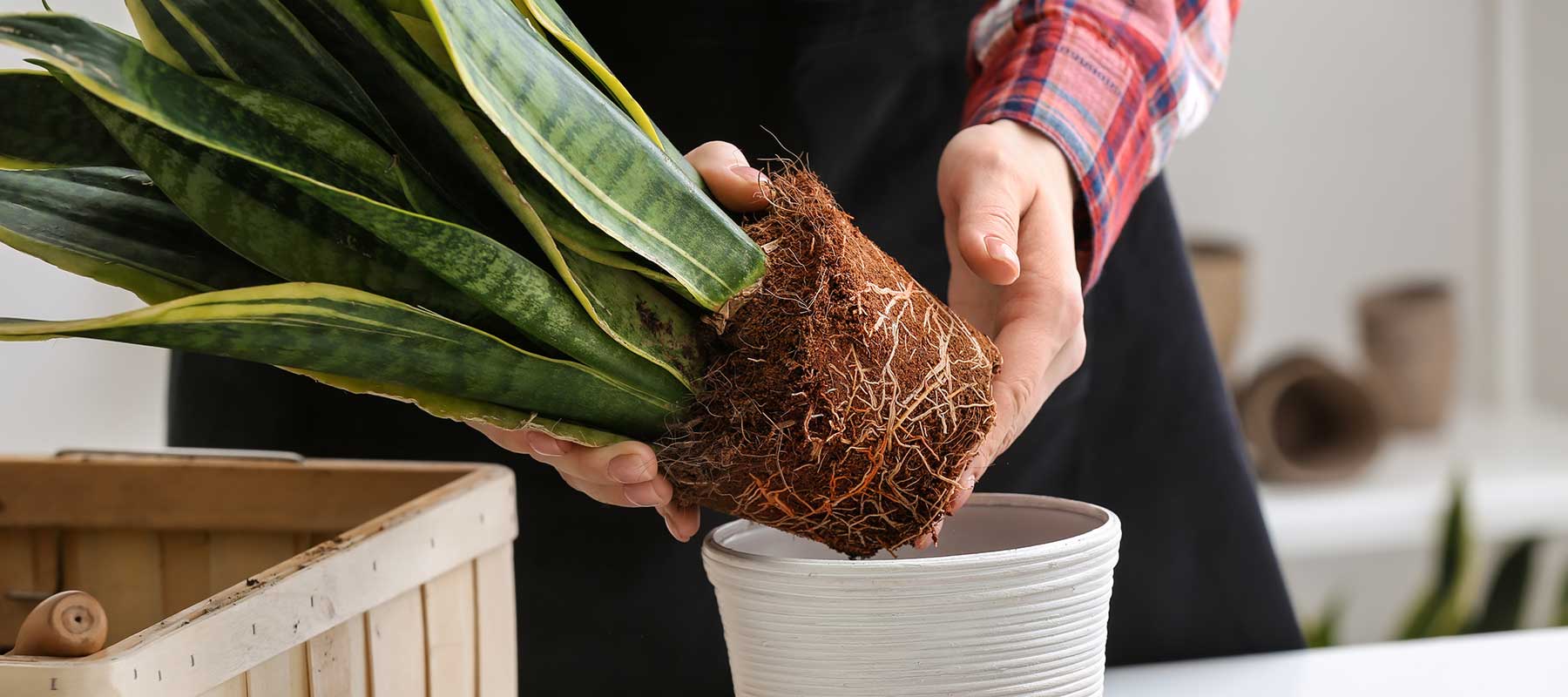
Root-Bound Plants:
- Snake plants have strong roots that can become root-bound when they outgrow their current container.
- Signs of a root-bound plant include roots emerging from the drainage holes, the plant falling over repeatedly, or roots filling the entire pot.
Depleted Soil Nutrients:
- Over time, the soil in which snake plants are planted can become depleted of nutrients essential for their growth and health.
- Repotting with fresh soil provides the plant with a new source of nutrients, promoting better growth and vitality.
Improving Overall Health:
- Repotting snake plants helps in maintaining their overall health by providing them with fresh soil that drains well and supports healthy root growth.
- It allows for the removal of any damaged roots or leaves, ensuring the plant’s continued vigor and vitality.
Snake plants are resilient and adaptable houseplants that can thrive even when slightly root-bound; however, repotting them every 4-6 years is generally recommended to support their long-term health and growth. By understanding the reasons behind repotting snake plants, you can ensure that your beloved plants continue to flourish and thrive in their environment.
Identifying the Right Time to Repot Snake Plants
When it comes to repotting snake plants, timing is crucial for ensuring the plant’s health and vitality. Recognizing the signs that indicate the need for repotting and understanding the optimal season for this task are essential. Here’s a detailed overview:
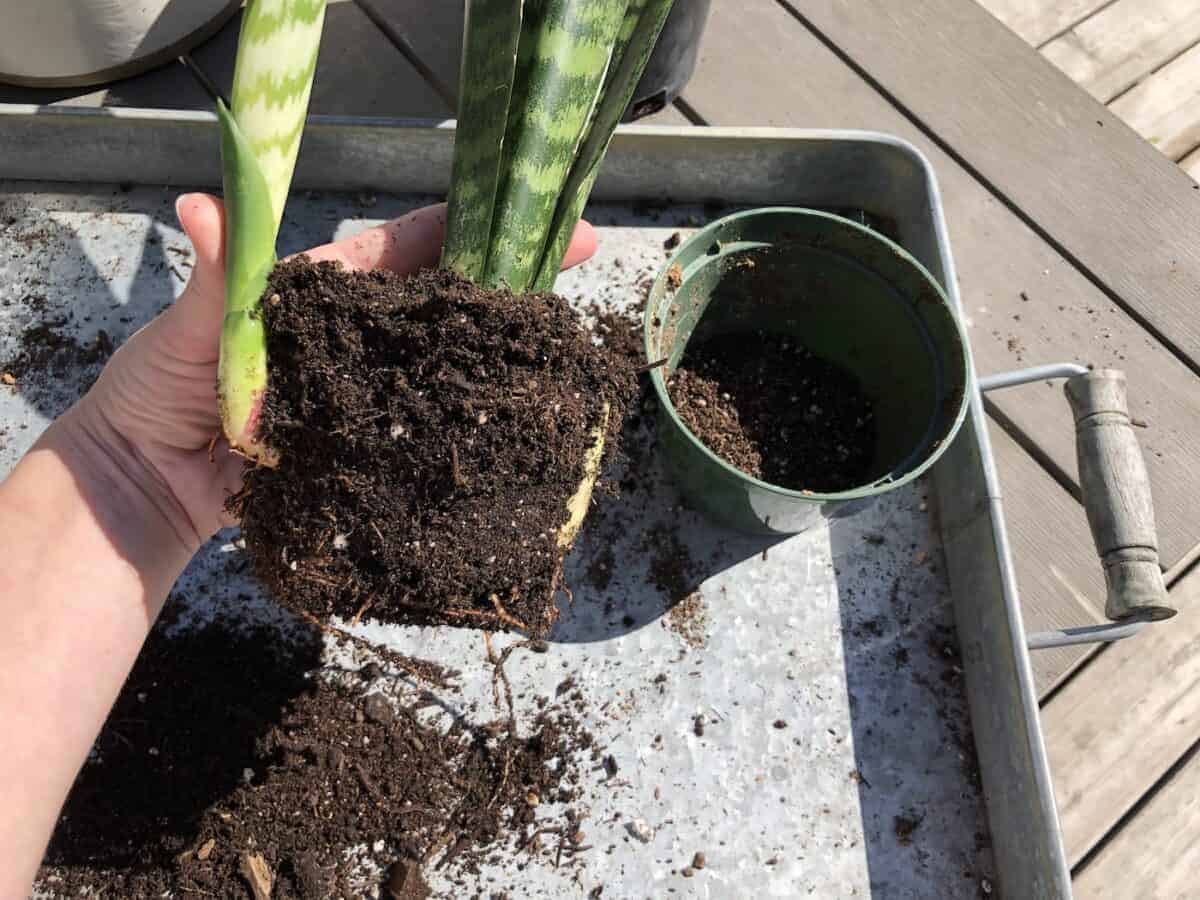
Signs that Indicate the Need for Repotting:
- Roots Growing Out: If you observe roots emerging from the drainage holes or circling around the pot, it’s a clear sign that the plant has outgrown its current container and requires more space.
- Compacted Soil or Stunted Growth: Compact soil or slow growth can indicate depleted nutrients in the soil, prompting the need for repotting to refresh the plant’s environment and promote healthier growth.
- Health and Appearance: Signs like stunted growth, yellowing or browning leaves, top-heaviness, or wilting indicate that repotting can help rejuvenate the plant’s root system and overall health.
Optimal Season for Repotting:
- Spring or Early Summer: The best time to repot snake plants is during spring or early summer when they are actively growing and can quickly adapt to a new container.
- Recovery and Establishment: Repotting in warmer months allows the plant to recover and establish itself before the slower growth period in cooler months, ensuring a smoother transition.
While spring and early summer are ideal for repotting snake plants, immediate action should be taken if urgent signs of distress or root-bound conditions are observed, regardless of the season. By understanding these timing considerations, you can effectively maintain the health and vigor of your snake plants through timely repotting practices.
Selecting the Right Pot for Snake Plants
Choosing the proper pot is crucial for the well-being and growth of your snake plant. When selecting a pot, consider the following key factors:
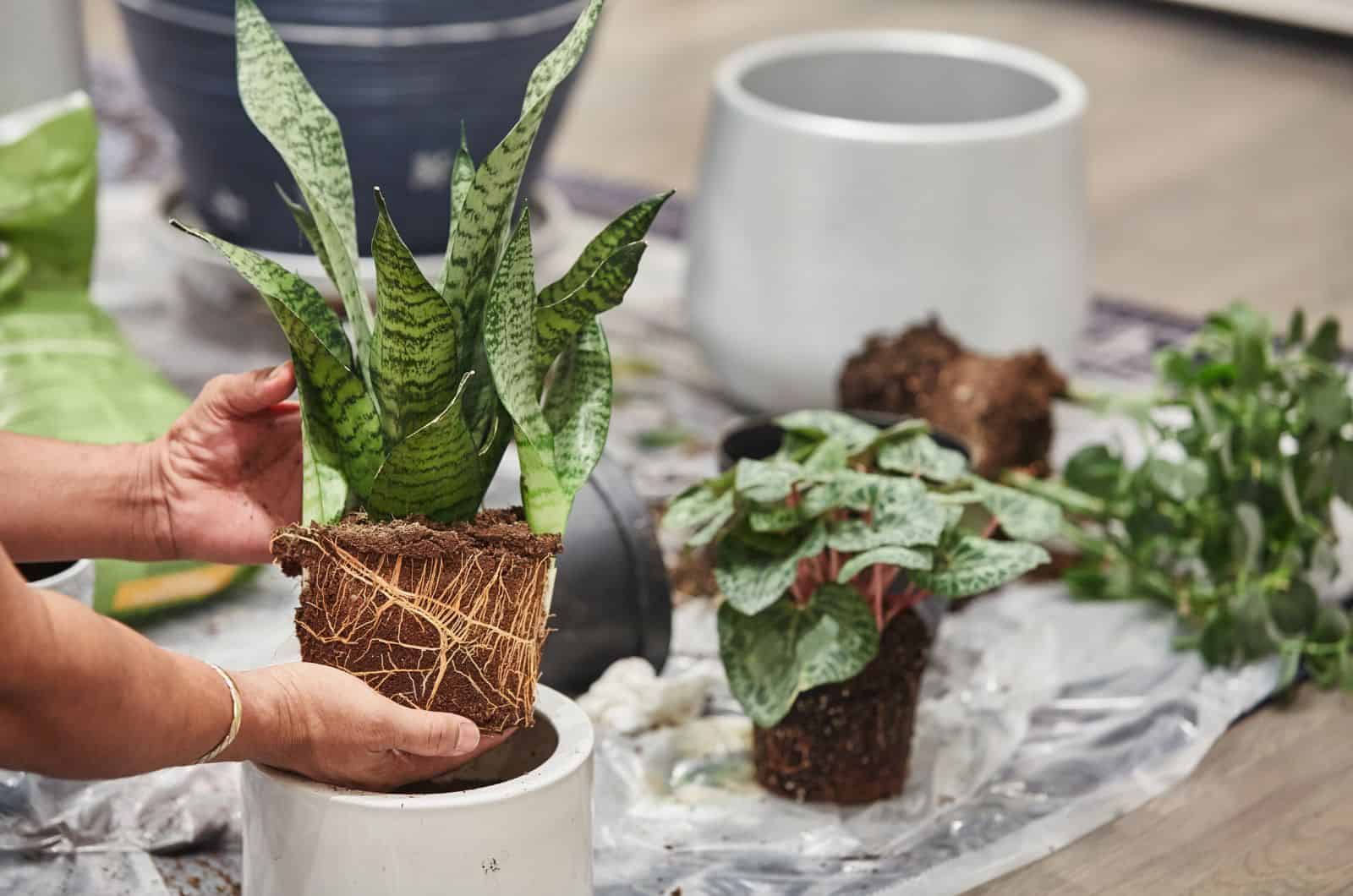
Size of the Pot:
- Snake plants prefer a tight fit, so opt for a pot that is just slightly larger than their root ball to prevent waterlogging and promote healthy growth.
- The ideal pot size for a snake plant is at least 18 inches in diameter and 24 inches deep, providing ample space for growth.
Material of the Pot:
- Clay or terracotta pots are recommended for snake plants as they offer better airflow and drainage compared to plastic pots.
- While ceramic or decorative pots can be used, ensure they have drainage holes to prevent water accumulation at the bottom.
Drainage:
- Snake plants dislike sitting in soggy soil, so it’s essential to choose a pot with adequate drainage holes to prevent overwatering and ensure root access to oxygen.
- Proper drainage is crucial for preventing root rot and maintaining the plant’s health and vitality.
The following table explains about the different pot for snake plants:
| Pot Material | Drainage Holes | Size (Diameter) | Depth | Price Range |
|---|---|---|---|---|
| Terra Cotta | Yes | 6-8 inches | 6-8 inches | $5 – $15 |
| Ceramic | Yes | 8-10 inches | 8-10 inches | $10 – $25 |
| Plastic | Yes | 6-8 inches | 6-8 inches | $3 – $10 |
| Concrete | Yes | 8-10 inches | 8-10 inches | $15 – $30 |
When repotting your snake plant, consider these factors to provide an optimal environment for its growth and well-being. By selecting the right pot size, material, and ensuring proper drainage, you can help your snake plant thrive and flourish in its new home.
Here is a review of some pots that i have been using for a long time and they are wonderful in the quality. I highly recommend these pots for the use as for repotting or any other thing your like to do.
✅ Lightweight: Despite being durable, these pots are lightweight, making them easy to handle and move around.
✅ Drainage Holes: The pots come with pre-drilled drainage holes at the bottom, preventing waterlogging and root rot.
✅ Removable Saucer: The inclusion of a removable saucer helps in collecting excess water, protecting surfaces from damage.
✅ Modern Design: The contemporary design and fresh colors allow these planters to blend seamlessly into any indoor or outdoor decor.
✅ UV Resistant: The plastic used is UV resistant, ensuring that the color of the planters does not fade over time.
✅ Versatility: Suitable for a variety of plants, including flowers, vegetables, herbs, and even snake plants.
✅ Made in the USA: Manufactured in the USA by The HC Companies, boasting over 35 years of experience in horticultural containers.
❌ Thin Material: Some customers have noted that the plastic material used for the planters is thin and flexible, potentially affecting its stability in windy conditions.
❌ Missing Parts: In rare cases, customers have reported receiving pots with missing saucers or other components, which can be inconvenient.
❌ Warping: Due to the thinness of the plastic, there have been instances of pots arriving warped, affecting their appearance and functionality.
❌ Limited Color Options: While the available colors may suit many preferences, some users might desire a broader range of color choices to match their specific decor.
❌ International Compatibility: Products with electrical plugs are designed for use in the US, requiring adapters or converters for international usage, which adds to the overall cost and complexity.
❌ Packaging: Some customers have experienced issues with inadequate packaging, leading to damaged or warped pots upon delivery.
❌ Return Process: Returning items due to issues like missing parts or damage may involve additional costs and hassle, depending on the seller’s return policy and international shipping regulations.
✅ Lightweight: Made from plastic, the pot is lightweight, making it easy to move around as needed. This feature is particularly beneficial for individuals who like to rearrange their indoor or outdoor decor frequently or for those who have limited physical strength.
✅ Maneuverability: Customers have praised the pot for its maneuverability. Its lightweight nature allows for easy handling and placement, enhancing the convenience of potting and caring for plants.
✅ Sturdiness: While being lightweight, the pot is also noted for its sturdiness. Despite its plastic construction, it offers sufficient support for plants without compromising on durability. This ensures that plants remain securely housed within the pot, reducing the risk of accidents or damage.
✅ Durability: Although constructed from plastic, the pot is designed to withstand outdoor elements such as sunlight, rain, and temperature fluctuations. This durability ensures that the pot maintains its aesthetic appeal and functionality over time, offering long-term value to customers.
❌ Glossy Finish: The pot features a glossy finish, which may not be to everyone’s taste. Some customers may prefer a matte or textured finish for a more subdued or rustic look. Additionally, the glossy surface may show smudges or scratches more prominently, requiring more frequent cleaning to maintain its appearance.
❌ Limited Color Options: While the pot is available in white, some customers may desire a broader range of color options to match their personal preferences or existing decor. Offering additional color choices could enhance the pot’s appeal and suitability for various aesthetic styles.
❌ Plastic Appearance: Despite its functionality, some customers may perceive plastic pots as less visually appealing compared to pots made from natural materials such as clay or stone. While the pot is designed to mimic the appearance of ceramic, discerning customers may still prefer the authenticity of traditional materials.
❌ Drainage Hole Size: A few customers have noted that some pots may require enlarging the drainage holes for optimal water drainage. While this can be addressed with simple tools, such as scissors, it adds an extra step to the potting process and may inconvenience some users.
✅ Large capacity: Spacious enough to accommodate a good amount of plants without overcrowding.
✅ Lightweight: Despite being made of concrete, it’s lighter than traditional concrete planters, making it easier to move.
✅ Weather and UV resistant: Suitable for both indoor and outdoor use.
✅ Modern design: Sleek and minimalist appearance adds a contemporary touch to any space.
✅ Drainage hole: Equipped with a drainage hole and rubber plug for proper water drainage.
✅ Versatile: Can be used for a variety of plants and fits well in various landscape designs.
❌ Fragility: Being made of concrete, it may chip or crack if subjected to significant impact.
❌ Mixed quality: Opinions on the quality of the product vary among customers, with some expressing dissatisfaction with the overall quality.
Preparing the Potting Mix for Snake Plants
Creating the perfect potting mix for your snake plants is essential to ensure their well-being and growth. Here’s a comprehensive guide on how to prepare the ideal potting mix:
Components of the Potting Mix:
- Potting Soil: Choose a high-quality potting soil specifically formulated for succulents or cacti, avoiding regular garden soil that can retain too much water.
- Perlite: Incorporate perlite, a lightweight volcanic rock that enhances soil drainage, aiming for a ratio of approximately 1 part perlite to 3 parts potting soil.
- Other Amendments: Consider adding coarse sand, pumice, or vermiculite to improve nutrient content and drainage in the potting mix.
Mixing Instructions:
- Soil Selection: Opt for a well-draining potting soil with a slightly acidic to alkaline pH range of 5.5-7.5 for snake plants.
- Perlite Addition: Mix perlite into the potting soil at a ratio of 1:3 to enhance drainage and prevent waterlogging.
- Additional Amendments: Optionally, include coarse sand, pumice, or vermiculite to create a well-aerated soil mix that promotes healthy root development.
Preparation Steps:
- Thoroughly mix all components together to ensure even distribution and consistency in the potting mix.
- The resulting mix should feel light, airy, and well-draining, allowing excess water to flow away quickly and preventing root rot.
The following table explains about the preparing the potting mix for snake plants:
| Potting Mix Component | Purpose | Quantity (by volume) |
|---|---|---|
| 1. Succulent/Cactus Soil | – Provides good drainage. | 50% |
| 2. Perlite | – Improves aeration and drainage. | 30% |
| 3. Coarse Sand | – Enhances drainage and prevents compaction. | 20% |
| 4. Organic Matter (optional) | – Adds nutrients and improves soil structure. | Up to 10% |
By following these guidelines and preparing a well-draining potting mix with the right proportions of soil, perlite, and other amendments, you can provide your snake plants with an optimal growing medium that supports healthy root development and vibrant growth.
As an avid gardener and enthusiast of indoor plants, I recently purchased the Mosser Lee ML1113 Desert Sand for various gardening projects. After using it extensively, I must say it has greatly impressed me with its quality and versatility.First and foremost, the sand effectively improves the appearance of my house plants by providing a clean and attractive covering for the soil. This not only enhances the aesthetic appeal of my plants but also helps in retaining moisture, which is essential for healthy plant growth.
Moreover, I found the sand to be highly beneficial for loosening heavy or compacted soil, especially in potted plants. By incorporating it into the soil mix, I noticed improved drainage and better aeration, which are crucial for preventing waterlogging and promoting root health.One aspect that stands out about this product is its ease of use. Whether I’m layering it on top of the soil or mixing it into the potting mix, the sand disperses smoothly and evenly, without clumping or causing any mess.
Despite its many benefits, it’s essential to mention the safety precautions outlined by the manufacturer regarding potential health risks associated with silica exposure. While this is a concern, I ensure proper handling and take necessary precautions to minimize any risks.In conclusion, I highly recommend the Mosser Lee ML1113 Desert Sand for anyone looking to enhance the appearance of their indoor plants or improve soil conditions for better plant growth. Its high quality, versatility, and decorative appeal make it a valuable addition to any gardener’s toolkit.
- High-quality sand suitable for various uses including potting soil, decorative purposes, and horticultural projects.
- Helps improve the appearance of house plants by covering the soil and enhancing their aesthetic appeal.
- Can be used in clear vases, dish gardens, and terrariums for decorative purposes.
- Loosens heavy or compacted soil, promoting better plant growth and root development.
- Assists in retaining moisture, providing a healthier environment for plants.
- Easy to use and versatile, appreciated by professional interior decorators and users alike.
- Comes in a convenient larger size, offering better value for money.
- Positive customer reviews highlight its effectiveness in various applications, such as controlling fungus gnats and enhancing drainage.
- Some customers have experienced issues with packaging, with reports of bags splitting open during shipping, leading to spillage.
- Mixed feedback regarding drainage and sand quality, suggesting variability in product consistency.
- Relatively high shipping and import fees, particularly for international orders to Pakistan, impacting overall cost.
- Contains a warning about potential health hazards due to exposure to airborne particles of respirable size, which may cause cancer.
Watch video for more information:
FAQ
Why do snake plants need to be repotted?
Snake plants may need to be repotted for several reasons. One common reason is when the plant becomes root-bound, meaning its roots have outgrown the current pot and need more space to grow. Repotting can also help replenish depleted soil nutrients and improve the overall health of the plant.
How do I know when it’s time to repot my snake plant?
There are a few signs that indicate it’s time to repot your snake plant. If you notice roots growing out of the drainage holes or wrapping around the inside of the pot, it’s a clear sign that the plant is root-bound. Additionally, if the soil dries out quickly after watering or the plant seems to have stunted growth, it may be time to repot.
When is the best time to repot snake plants?
The ideal time to repot snake plants is during the spring or early summer when they are in their active growth phase. Avoid repotting during the winter months or when the plant is dormant as it may cause unnecessary stress.
What should I consider when selecting a pot for my snake plant?
When choosing a pot for your snake plant, consider the size, material, and drainage. Ensure that the pot is large enough to accommodate the plant’s roots and allow for future growth. Opt for a pot made of a breathable material like terracotta or a porous plastic to promote better airflow and prevent waterlogged roots. Lastly, make sure the pot has drainage holes to prevent water accumulation.
How do I prepare the perfect potting mix for snake plants?
To create a well-draining potting mix for snake plants, combine the right proportions of soil, perlite, and other amendments. Use a well-draining soil mix, such as a cactus or succulent mix, and add perlite or coarse sand to improve drainage. You can also add organic matter like compost or peat moss to enhance the soil’s fertility. Aim for a mix that retains some moisture but allows excess water to drain freely.

Studied Agricultural Engineering-Plant Protection at University of California, Davis.
Head of Content writing team at Southelmontehydroponics.com

